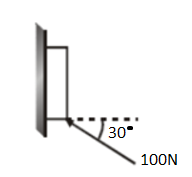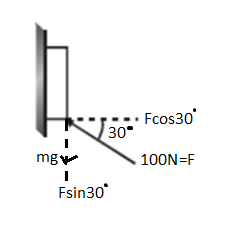Question
Question: A force of \[100N\] is applied on a block of mass \[3kg\] as shown in figure. The coefficient of fri...
A force of 100N is applied on a block of mass 3kg as shown in figure. The coefficient of friction between the surface of the block is0.25 . The friction force acting on acting on the block is:

A) 15N downwards
B) 25N upwards
C) 20N downloads
D) 20N upwards
Solution
In this question, we have to first resolve the components of F=100N. After resolving the components, we can find the net force on the block. We can find the limiting force between the block and the surface by using the formula Fl=μFcos30∘. After comparing the net force and the limiting force, we can find the friction force acting on the block.
Complete step by step solution:
According to the question, we have a block of mass m=3kg. A force of F=100Nis applied on the block. Now, resolving the components of the force F=100N, we get the components according to the following figure.

Both components mgsin30∘ and mgcos30∘ works towards the block. So, mgsin30∘works upwards on the block. The weight of the block of mg works downwards on the block. So, net force fa will be given as-
fa=Fsin30∘−mg
Now, substituting the values of force (F=100N) , sin30∘=21 , m=3kgand g=10 in the above equation, we get-
This net force is directed upwards on the block.
Now, the limiting frictionFl between the surface and the block will be given as
Fl=μF
Substituting the value of F=Fcos30∘and μ=0.25=41 in the above equation, we get-
Fl=μFcos30∘ Fl=41×100×23 Fl=25×0.866 Fl=21.65N
The limiting friction is greater than the net force on the block. So, the block will not slip.
So,
fr=fa=20N
Hence the friction force acting on the block is equal to 20Nand it is directed upwards.
Therefore, option D is correct.
Note: We have to keep in mind that the force is acting towards the block. So, both the components will also be directed towards the block i.e. vertical component is directed upwards. If the limiting friction is greater than the net force then the net force is equal to the friction force acting between the block and surface.
